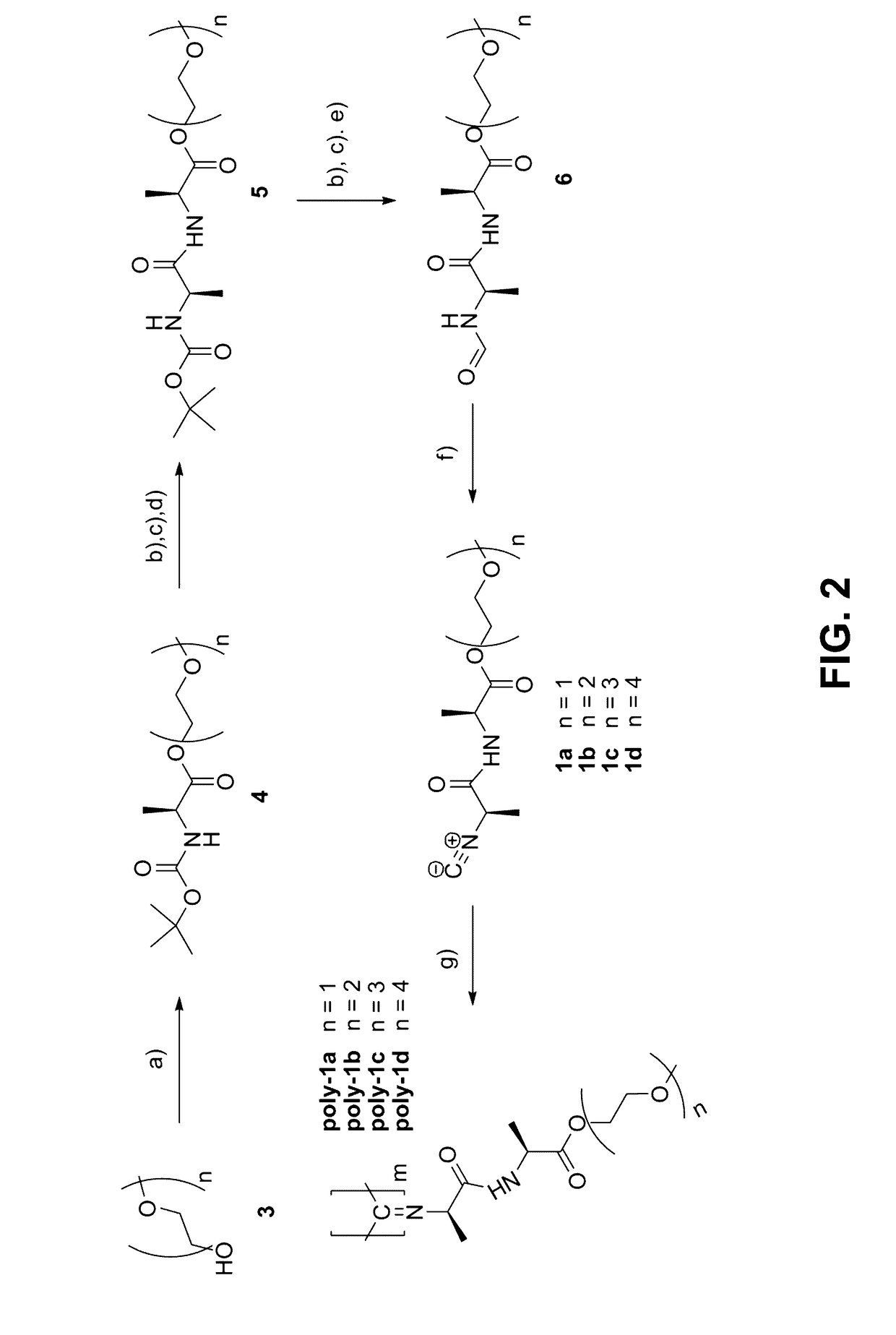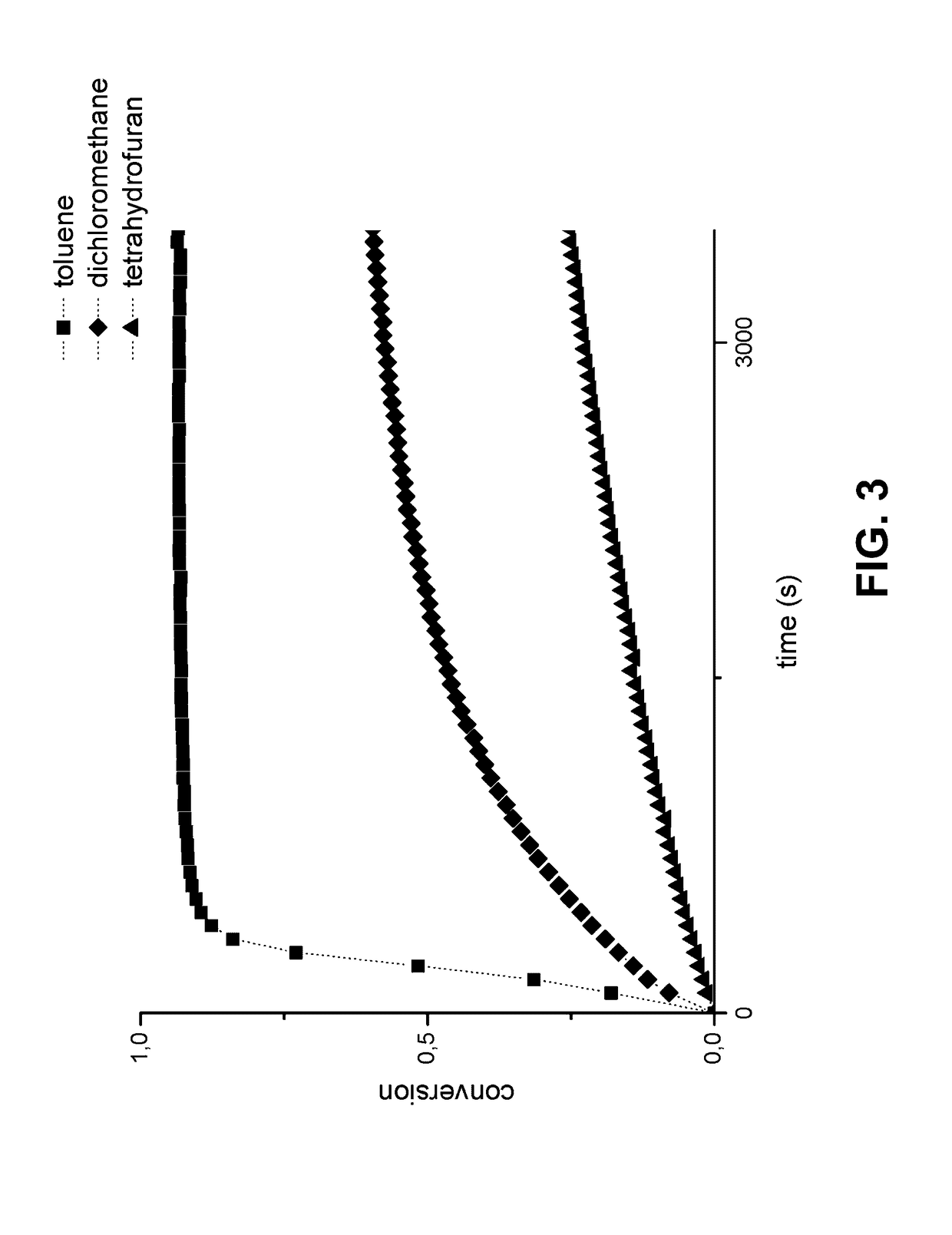Method for the preparation of high molecular weight oligo(alkylene glycol) functionalized polyisocyanopeptides
a polyisocyanopeptide, high molecular weight technology, applied in the direction of polyamide coatings, coatings, etc., can solve the problems of failure in the polymerization of oligoethylene isocyanide monomers, achieve perfect transparency, reduce erosion, and stable porous film
- Summary
- Abstract
- Description
- Claims
- Application Information
AI Technical Summary
Benefits of technology
Problems solved by technology
Method used
Image
Examples
example 1
Materials and Reaction Conditions
[0112]Synthesis of 2-methyloxyethyloxyethyl-N-boc-(L)-alaninate (2a)
[0113]Unless mentioned, CD spectra were taken from 1 mg / ml samples in freshly distilled dichloromethane or mQ water (18.2 MΩ) on a JASCO® J-810 spectrometer.
[0114]The cell was thermostated at 25° C. with the JASCO® peltier module or heated / cooled on the desired range of temperatures with a gradiant rate of 1° C / minute.
[0115]NMR spectra were taken on BRUKER® AVANCE® 200 or 300 MHz. When recorded in deuterated chloroform, the chemical shifts were calibrated on TMS signal.
[0116]IR spectra were taken on a TENSOR® 27 spectrometer run with Opus (BRUKER® Optics, Marne la Vallee, France), from 1 mg / ml solutions in chloroform.
[0117]TAPPING MODE™ AFM measurements were conducted on a Dimension 3100 microscope (Digital Instruments, Santa Barbara, Calif.) controlled with nanoscope IV controller (Digital Instruments, Santa Barbara, Calif.).
[0118]The measurements were done on mica samples prepared ...
example 2
Synthesis of 2-methyloxyethyloxyethyloxyethyloxyethyl-N-boc-(L)-alaninate (2b)
[0122]This compound was synthesized according to the same procedure as described in Example 1.
[0123]Compound 2b was prepared using the same procedure as described for the synthesis of 2a with the following reactants and solvents: 2-(2-(2-methoxyethoxy)ethoxy)ethanol (1.32 g, 8 mmol), 4-N,N-(dimethyl)aminopyridine (100 mg, 0.81 mmol), N-Boc-(L)-Alanine (1.51 g, 8 mmol) and DCC (1.67 g, 8.1 mmol) in dichloromethane (25 mL). Column chromatography (SiO2, 0.060 mm to 0.200 mm / 1% MeOH in CH2Cl2) yielded compound 2b as a colorless to pale yellow oil (2.35 g, 7.1 mmol, 86%).
[0124]1H NMR (CDCl3, 300 MHz): 5.17 (br s, 1H, —NH—); 4.35-4.27 (br m, 3H, —CH(CH3)—, —COOCH2—); 3.71 (t, J=4.5 Hz, 2H, —COOCH2CH2—); 3.67-3.63 (br s, 6H, —OCH2CH2OCH2CH2OCH3); 3.57-3.53 (m, 2H, CH2CH2OCH3); 3.38 (s, 3H, —OCH3); 1.45 (s, 9H, (CH3)3C—); 1.39 (d, J=7.2 Hz, —CH(CH3)—) 13C NMR (CDCl3, 75 MHz): 172.8 (—CH(CH3)COO—); 154.6 (—NHCOO—);...
example 3
Synthesis of 2-methyloxyethyloxyethyl-(L)-alaninamido-(D)-alaninate (3a)
[0127]Compound 2a (2.0 g, 6.8 mmol) was treated with HCl (20 mL, 2 M) in ethyl acetate at room temperature. The deprotection was followed by TLC. When no protected compound remained (˜1 hour), the solvent was evaporated under reduced pressure. The crude material was dissolved in tertbutyl alcohol (10 mL), which was subsequently evaporated (two times). The residual tertbutyl alcohol was removed by azeotropic distillation with CH2Cl2 and the crude product was used without further purification for the next coupling reaction.
[0128]The deprotected compound, 1-hydroxy-benzotriazole hydrate (HOBt, 1.03 g, 6.9 mmol) and N-Boc-(D)-alanine (1.29 g, 6.8 mmol) were suspended in freshly distilled CH2Cl2 (50 mL), N,N′-diisopropyl-N″-ethylamine (DIPEA, 1.2 mL) was added dropwise and the mixture was stirred at room temperature until almost all the solids were dissolved. The mixture was cooled down to 0° C. (ice bath), and DCC (...
PUM
| Property | Measurement | Unit |
|---|---|---|
| diameter | aaaaa | aaaaa |
| diameter | aaaaa | aaaaa |
| pore size | aaaaa | aaaaa |
Abstract
Description
Claims
Application Information
 Login to View More
Login to View More - R&D
- Intellectual Property
- Life Sciences
- Materials
- Tech Scout
- Unparalleled Data Quality
- Higher Quality Content
- 60% Fewer Hallucinations
Browse by: Latest US Patents, China's latest patents, Technical Efficacy Thesaurus, Application Domain, Technology Topic, Popular Technical Reports.
© 2025 PatSnap. All rights reserved.Legal|Privacy policy|Modern Slavery Act Transparency Statement|Sitemap|About US| Contact US: help@patsnap.com



